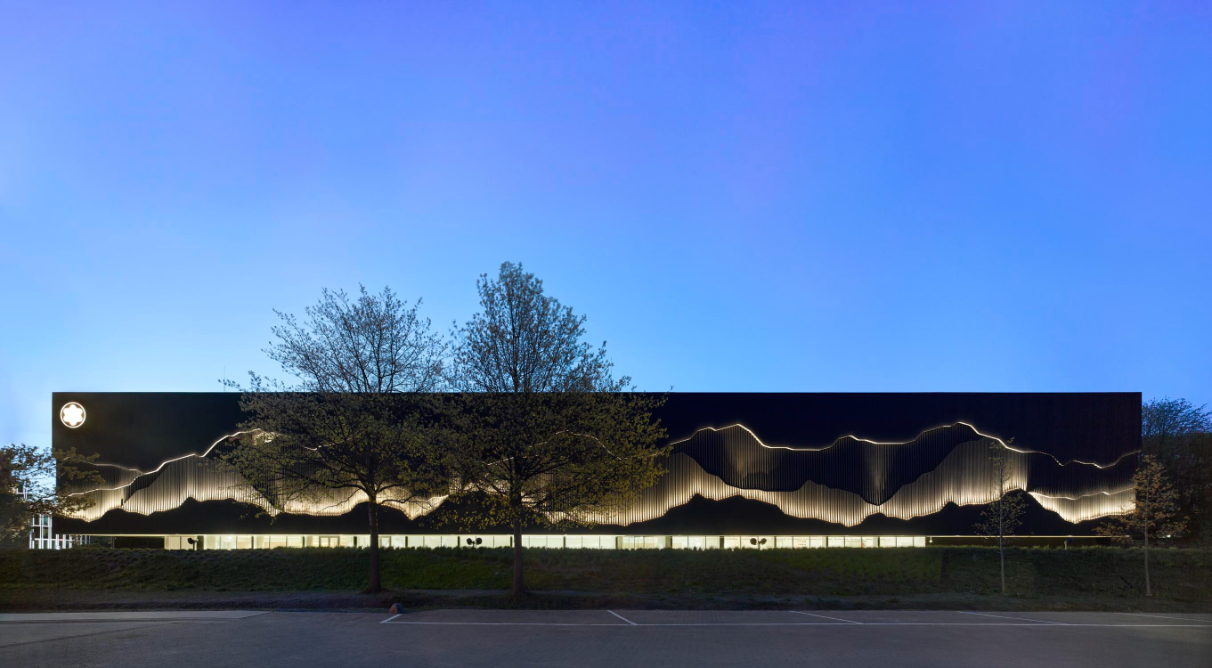Etiketler
Montblanc binasının siyah cephesi estetik, göz alıcı ve yapısal olarak iddialı
Yazı aracı üreticisi Montblanc , Hamburg'da kalıcı bir sergi kurdu. Yeni bina, siyah, ayrıntılı bir şekilde tasarlanmış cephesiyle öne çıkıyor. Bu bina kaplamasının oluşturulması, sorumlulara olağanüstü bir şekilde çözülen büyük zorluklar sundu.
Yüksek kaliteli yazı gereçleri üreticisi Montblanc, Hamburg'da Büro Projektile'nin senografisi ve iç tasarımıyla kalıcı bir sergi açtı. Şirketin genel merkezinin hemen yanında bulunan muhteşem yeni bina, üreticinin tarihini ve zarif ürünlerini 3.600 m²'lik bir alanda ve üç katta sergiliyor. Binanın tasarımında uluslararası üne sahip planlamacılar yer aldı: Nieto Sobejano Arquitectos ofisi mimari tasarımdan sorumluyken, Werner Sobek'in ofisi teknik bina ekipmanının, destekleyici yapının ve cephenin planlamasını üstlendi. İkincisi, ziyaretçilere binaya girmeden önce bile içeride ne bekleyecekleri konusunda bir fikir veriyor: Güney, batı ve doğu cephelerinde, olağanüstü prefabrik beton elemanlar yalnızca bilinen şirket logosunu değil, aynı zamanda şirkete adını veren dağın kabartmasını da gösteriyor - Mont Blanc. Ayrıca binanın biçimi ve cephesinin özel rengi, sergide yer alan ince kalemler, tükenmez kalemler, finelinerlar ve benzeri kalemlerin tarihi ambalajlarını anımsatıyor.
İncelikli tasarım, muazzam boyut
W+P Gesellschaft für Projektrealisierung mbH, inşaatta yer alan 60'tan fazla esnafı denetledi ve koordine etti. Bunu yaparken G. Büter inşaat şirketine güvendi. İkincisi, genel müteahhit rolünü üstlendi ve cephe elemanlarının üretimi, nakliyesi ve montajı için BWE-Bau prekast tesisini görevlendirdi; bu zorlu bir görevdi. Bu, bazıları 2,7 x 9,0 m boyutlarına kadar ulaşan ve birçoğunun başka hiçbir panelde tekrarlanmayan bir geometriye sahip olan 315 prekast panelin oluşturulması gerektiği anlamına geliyordu. Ayrıca, prekast tesisindeki ekip, bazı yerlerde 13,5 cm'ye kadar yüksekliğe sahip üç farklı kabartma tipine sahip panelleri üretme zorluğuyla karşı karşıyaydı. Donatı çeliğinin gerekli beton örtüsüyle birlikte, bu, yaklaşık 7-10 cm'lik bir plaka kalınlığı ve cephe sabitlemesinin gerekli ankraj derinliği için daha da büyük bir plaka kalınlığı ile sonuçlanacaktı. Ancak aynı zamanda cephe ağırlığının mümkün olduğunca düşük olması gerektiği belirtildi.
Teknik detaylar
- Cephe büyüklüğü: 2.800 m²
- Cephe elemanları : Her biri 2,7 x 9,0 m boyutlarına kadar 315 adet prefabrik panel
- Kabartma yüksekliği: 13,5 cm'ye kadar
- Üç parçalı yapı:
-Kabartma yapı
-3 cm kalınlığında taban/yeniden dağıtım plakası
-entegre cephe süspansiyonu ile ağlar ve kalınlaştırma - İki somut formülasyon:
-Hafif beton: rölyef ve taban plakası için → cephe ağırlığının azaltılması
-Normal beton: ağlar için → çekme dayanımının artırılması - Çelik takviye: kısmen ağlar ve rölyef alanları için
- Tekstil takviyesi: Çatlak genişliğini sınırlamak için solidian GRID (epoksi reçine emdirilmiş cam elyafları) kullanımı
Special structure
The employees of the planning office Sobek therefore decided on a three-part structure for the prefabricated facade elements. This was composed as follows: firstly the relief, secondly a 3 cm thick (base/redistribution) plate for the relief and thirdly the webs and thickenings in which the facade suspension is integrated. These should also give the plate additional stability. Furthermore, the engineers planned for two different concrete compositions within one element. The first two parts were made of lightweight concrete and normal concrete was used for the webs. This was an unusual combination, but it had several advantages: in view of the black coating of the façade elements, it was foreseeable that these would expand under the influence of heat. But thanks to the two concrete formulations, the coefficient of thermal expansion could be reduced and at the same time the tensile strength of the elements increased.
Steel reinforcement plus glass fiber fabric
And there were also differences in the reinforcement of the façade elements: While the webs and partly the relief were provided with a normal reinforcement, the panels were additionally given a textile reinforcement: the solidian GRID. This is a mesh made of epoxy resin-impregnated glass fibers. It has the advantage that it does not corrode, has a tensile strength that is up to twice as high (characteristic tensile strength > 1,100 N/mm²) as that of classic steel meshes, and is extremely light. The manufacturer has specialized in the production of non-metallic reinforcement, whereby it also supports its customers in the planning phase. It offers the solidian GRID in the standard dimensions of 6.0 x 2.30 m – whereby other dimensions and three-dimensionally shaped elements can also be supplied on request. In the Montblanc House, it was used to limit the width of the cracks and thus make it possible to design the 3 cm panels without steel reinforcement or even to design them at all. (The static proof was carried out on the basis of an unreinforced concrete slab). This meant that the weight of the façade panels could be kept as thin and light as possible while still complying with the usual rules of technology.
Photos: © Montblanc, Fotograf: Roland Halbe










